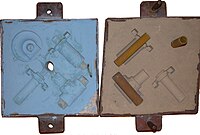
Photo from wikipedia
A kind of cylinder sand mold was designed to investigate the heat-transfer-coefficients (HTCs) between aluminum alloy and organic/inorganic binder bonded sand mold during the solidification processes. Temperature during the solidification… Click to show full abstract
A kind of cylinder sand mold was designed to investigate the heat-transfer-coefficients (HTCs) between aluminum alloy and organic/inorganic binder bonded sand mold during the solidification processes. Temperature during the solidification process was recorded and input into the simulation software. The inverse model of MAGMA was used to calculate the HTC based on the actual temperature. Results show that the temperature of the inorganic sand mold increased faster than the organic sand mold; while the temperature of the casting part with the inorganic sand mold decreased faster. The optimal HTCs between Al and the organic/inorganic sand mold are confirmed to be 300 to 700 and 1000 to 1800 W·m−2·K−1, respectively, along with the change of solid-liquid phase line. The simulated temperature curves show the same trend as the measured ones. The maximum deviation between the two temperature curves are 17.32 °C and 18.77 °C for castings by inorganic and organic sand molds.
Journal Title: China Foundry
Year Published: 2019
Link to full text (if available)
Share on Social Media: Sign Up to like & get
recommendations!